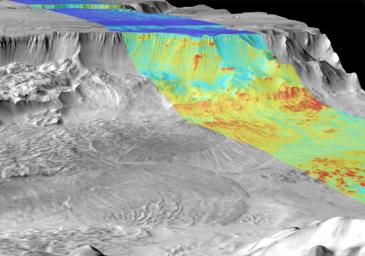
|
Melas Chasma, Day and Night.
- Click the image above for a larger view
- Full-Res JPEG (1276 x 895) (171.7 kB)
- Full-Res TIFF (1276 x 895) (1.5 MB)
Caption:
This image is a mosaic of day and night infrared images of Melas Chasma taken by the camera system on NASA's Mars Odyssey spacecraft. The daytime temperature images are shown in black and white, superimposed on the martian topography. A single nighttime temperature image is superimposed in color. The daytime temperatures range from approximately -35 degrees Celsius (-31 degrees Fahrenheit) in black to -5 degrees Celsius (23 degrees Fahrenheit) in white. Overlapping landslides and individual layers in the walls of Melas Chasma can be seen in this image. The landslides flowed over 100 kilometers (62 miles) across the floor of Melas Chasma, producing deposits with ridges and grooves of alternating warm and cold materials that can still be seen. The temperature differences in the daytime images are due primarily to lighting effects, where sunlit slopes are warm (bright) and shadowed slopes are cool (dark). The nighttime temperature differences are due to differences in the abundance of rocky materials that retain their heat at night and stay relatively warm (red). Fine grained dust and sand (blue) cools off more rapidly at night. These images were acquired using the thermal infrared imaging system infrared Band 9, centered at 12.6 micrometers.
Background Info:
Jet Propulsion Laboratory, a division of the California Institute of Technology in Pasadena, manages the 2001 Mars Odyssey mission for NASA's Office of Space Science in Washington, D.C. Investigators at Arizona State University in Tempe, the University of Arizona in Tucson and NASA's Johnson Space Center, Houston, operate the science instruments. Additional science partners are located at the Russian Aviation and Space Agency and at Los Alamos National Laboratories, New Mexico. Lockheed Martin Astronautics, Denver, is the prime contractor for the project, and developed and built the orbiter. Mission operations are conducted jointly from Lockheed Martin and from JPL. Aviation and Space Agency and at Los Alamos National Laboratories, New Mexico. Lockheed Martin Astronautics, Denver, is the prime contractor for the project, and developed and built the orbiter. Mission operations are conducted jointly from Lockheed Martin and from JPL.
Cataloging Keywords:
| Name | Value | Additional Values |
|---|---|---|
| Target | Mars | |
| System | ||
| Target Type | Planet | |
| Mission | 2001 Mars Odyssey | |
| Instrument Host | Mars Odyssey | |
| Host Type | Orbiter | |
| Instrument | Thermal Emission Imaging System (THEMIS) | |
| Detector | ||
| Extra Keywords | Color, Dust, Infrared, Shadow, Thermal | |
| Acquisition Date | ||
| Release Date | 2002-12-07 | |
| Date in Caption | ||
| Image Credit | NASA/JPL/ASU | |
| Source | photojournal.jpl.nasa.gov/catalog/PIA03741 | |
| Identifier | PIA03741 | |
